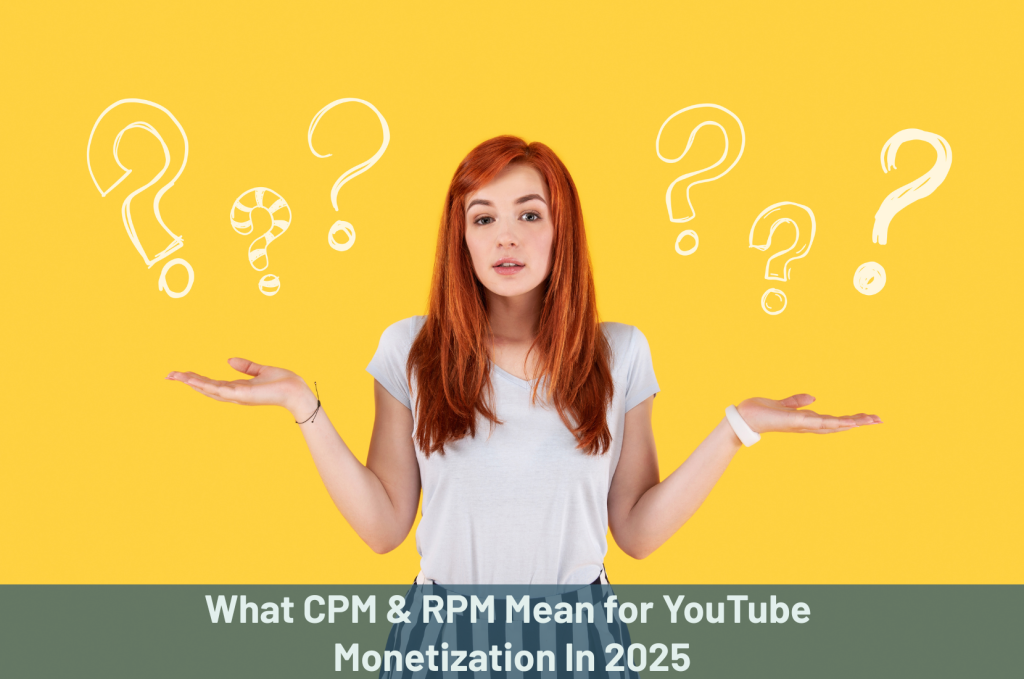
Monetizing your content on YouTube isn’t just about views—it’s about understanding how much those views are actually worth. In 2025, creators often hear terms like CPM and RPM, but many still struggle to interpret them correctly.
This guide breaks down YouTube CPM (Cost Per Mille) and RPM (Revenue Per Mille), explaining how they work, what affects them, and—most importantly—how you can boost them to maximize your earnings. We’ll also include useful internal guides like how to get monetized fast and top monetization strategies to enhance your earning potential.
What is CPM on YouTube?
CPM stands for “Cost Per Mille,” which means the cost advertisers pay for every 1,000 ad impressions. It represents the gross amount paid by advertisers—not what you earn.
For example, if your CPM is $10, it means advertisers are willing to pay $10 per 1,000 views where ads appear. However, YouTube takes a cut (typically 45%), so your net earnings are reflected in RPM.
Factors affecting CPM:
- Content niche: Financial, tech, and educational content earn higher CPMs.
- Audience location: Advertisers pay more for viewers in countries like the U.S., Australia, and the UK.
- Ad types: Skippable, non-skippable, bumper, and display ads each yield different CPMs.
- Video length: Longer videos allow multiple ad placements, increasing total revenue.
What is RPM on YouTube?
RPM is the actual income you receive per 1,000 views, including ad revenue and other monetization sources like channel memberships, YouTube Premium, and Super Chats.
It’s calculated like this:
RPM = (Total Revenue / Total Views) x 1,000
If your total revenue is $300 for 50,000 views, your RPM is ($300 ÷ 50,000) × 1,000 = $6.00
That’s the number that matters most to creators.
Average CPM and RPM Rates by Niche in 2025
According to recent data, here’s what you can expect based on content categories:
| Niche | Avg CPM (USD) | Avg RPM (USD) |
|---|---|---|
| Finance & Investing | $20–$45 | $8–$20 |
| Tech & Gadgets | $10–$25 | $4–$12 |
| Health & Fitness | $7–$15 | $3–$7 |
| Education | $8–$22 | $4–$10 |
| Gaming | $2–$7 | $1–$3 |
| Lifestyle/Vlogs | $1.50–$4 | $0.50–$2 |
Niche is the biggest factor in your monetization potential. You can explore more in our guide to YouTube Monetization Strategies.
CPM & RPM by Country
Geographic location of your viewers also affects CPM. Here’s a rough breakdown:
| Country | Avg CPM |
|---|---|
| United States | $10.26 |
| Australia | $7.67 |
| Norway | $7.03 |
| United Kingdom | $6.50 |
| Canada | $6.45 |
| Germany | $5.95 |
| India | $0.83 |
| Philippines | $0.55 |
Want to grow your audience in high-CPM regions? Learn how to rank better on YouTube and reach global viewers.
How to Increase Your CPM and RPM
Now that you understand what CPM and RPM are, let’s talk about boosting them.
1. Target High-Paying Niches
Finance, tech, and education offer some of the best CPMs. If you’re passionate about those topics, building content around them pays off.
2. Longer Videos = More Ads
Videos over 8 minutes allow for multiple ad breaks, increasing your CPM and total earnings.
3. Add Subtitles for Global Reach
Adding accurate captions helps your content reach international (often higher-CPM) audiences.
4. Boost Audience Engagement
YouTube prioritizes videos that keep viewers watching. Higher engagement = more visibility = higher CPM. Check our tips to get more views.
5. Secure Your Channel
Revenue is worthless if your account gets hacked. Always secure your YouTube account and enable 2FA.
CPM vs RPM: What’s More Important?
- CPM shows how much advertisers are willing to pay for access to your audience.
- RPM shows how much you actually earn after YouTube’s cut and all other revenue streams are included.
To grow your YouTube business, focus on increasing RPM—because that’s your real-world income.
Complement RPM with Affiliate Revenue
RPM doesn’t include earnings from outside monetization. That’s why many creators add affiliate marketing to their income mix.
Promoting affiliate links in your video descriptions can yield $5 to $50 per conversion, depending on the product.
Explore our complete guide on Affiliate Marketing Strategies for YouTube to amplify your earnings.
Final Thoughts
Understanding YouTube CPM and RPM in 2025 is essential for growing your creator income. While CPM shows advertiser interest, RPM reveals your actual take-home pay. By optimizing your content, targeting the right niches, and leveraging additional income sources, you can earn significantly more from every thousand views.
Key next steps:
- Get your channel monetized fast: YouTube Partner Program Guide
- Explore monetization tools: YouTube Monetization Strategies 2025
- Expand into affiliate sales: Affiliate Strategies for YouTube
Want to go full-time on YouTube? Your journey starts with understanding how your content pays. Focus on value, strategy, and monetization—and watch your RPM grow.
